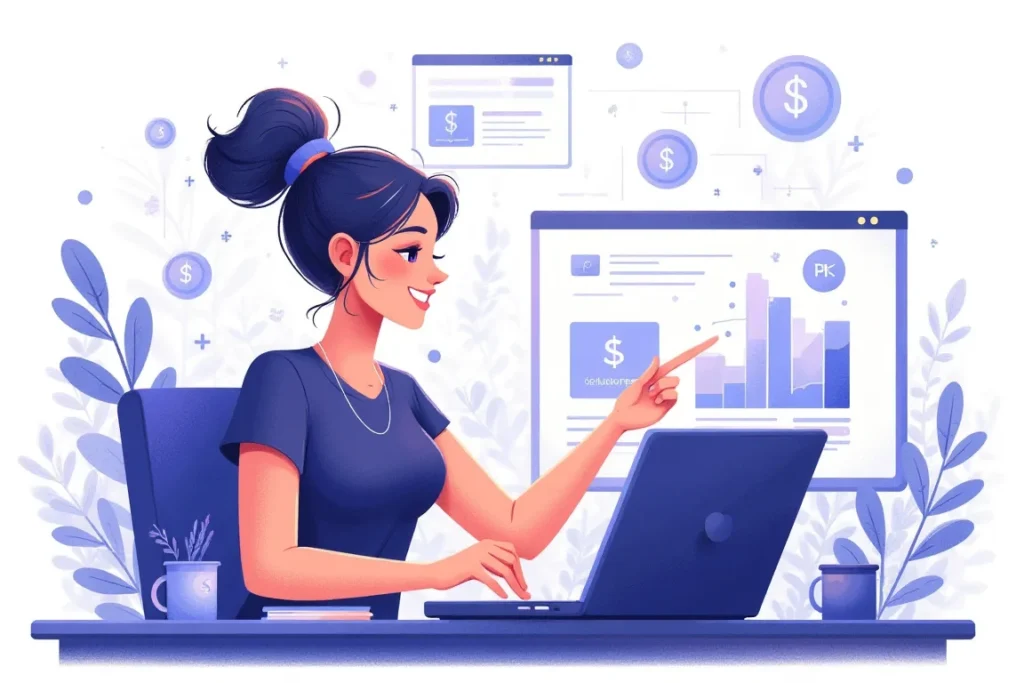Starting a business from home feels impossible when you’re staring at a blank screen, wondering what products to create. You’ve got the entrepreneurial spirit but lack the time, skills, or budget to develop original content from scratch. With PLR (Private Label Rights) products, you can build a profitable home business by selling pre-made digital products that others have already created for you.
Key Takeaways
Starting a PLR product business from home involves purchasing pre-made digital content with commercial rights, then customizing and reselling these products through your own online channels. Here’s what you need to know:
- Choose your niche based on market demand and personal interests
- Source quality PLR products from reputable platforms and suppliers
- Rebrand and customize content to make it unique to your business
- Set up sales channels like your own website, online store, or marketplace listings
- Market effectively using SEO, social media, and email marketing strategies
- Start with minimal investment – typically just the cost of PLR products and hosting
Want to skip the lengthy research process and start selling immediately? Ready-to-Sell Digital Products on plrbizhub.com letting you launch your PLR business this week instead of spending months sourcing and customizing products.
Understanding PLR Products And Their Potential
What exactly are PLR products? Think of them as digital building blocks for your business. PLR stands for Private Label Rights, which means you’re purchasing pre-made content along with the legal right to modify, rebrand, and resell it as your own product.
These aren’t just simple templates – we’re talking about complete digital products including eBooks, courses, planners, worksheets, graphics, and even entire business systems. The content is professionally created by experts in various fields, then sold with flexible usage rights.
The beauty of PLR lies in its time-saving potential. Instead of spending weeks researching, writing, designing, and formatting a digital product, you can have something ready to sell within hours of purchase.
Useful Articles:
Why PLR Business Works From Home
Running a PLR business from home offers incredible advantages that traditional businesses can’t match. You’re working with digital products only, which means no inventory, shipping, or storage concerns.
The startup costs are remarkably low. Most PLR products cost between $5-$50, and you can start with just a basic website and payment processor. Compare this to traditional retail businesses requiring thousands in initial inventory.
Scalability happens naturally. Once you’ve set up your systems, adding new products to your catalog takes minimal effort. You can expand into multiple niches without significant additional overhead.
The passive income potential is real. After initial setup and marketing, sales can happen automatically while you sleep, travel, or focus on growing other areas of your business.
Step-By-Step Guide To Starting Your PLR Business
Research And Niche Selection
Your first step involves identifying profitable niches where people actively seek digital solutions. Popular PLR niches include health and wellness, personal development, business and marketing, parenting, relationships, and hobbies like gardening or crafting.
Look for niches with these characteristics:
- Active online communities and forums
- Regular social media engagement around the topic
- Existing successful digital products in the space
- Problems that people pay to solve
I recommend starting with one focused niche rather than trying to cover everything. This helps you build authority and makes marketing much more effective.
Sourcing Quality PLR Products
Not all PLR products are created equal. You’ll find everything from high-quality, professionally designed materials to poorly written content that damages your reputation.
Quality indicators to look for include:
- Professional formatting and design
- Well-researched, accurate information
- Proper grammar and spelling
- Attractive graphics and layouts
- Clear licensing terms
Reputable PLR sources typically offer preview samples, detailed product descriptions, and responsive customer support. Avoid sources that seem too good to be true or don’t clearly explain usage rights.
Customization And Branding
Here’s where many beginners make mistakes – they sell PLR products without any modifications. This approach rarely succeeds because dozens of other people might be selling identical products.
Essential customization steps include:
- Adding your own branding, logo, and color scheme
- Rewriting introductions and conclusions in your voice
- Adding personal examples and case studies
- Creating new covers and graphics
- Updating outdated information or statistics
Advanced customization might involve combining multiple PLR products into a comprehensive course, breaking large products into smaller modules, or adding bonus materials you’ve created.
Useful Articles:
Setting Up Your Sales Channels
Building Your Own Website
Having your own website gives you complete control over pricing, customer relationships, and branding. WordPress remains the most popular choice for PLR sellers due to its flexibility and extensive plugin ecosystem.
Essential pages for your PLR website include:
- Professional homepage explaining your offerings
- Individual product pages with detailed descriptions
- About page establishing your credibility
- Contact information and customer support details
- Clear terms of service and privacy policy
E-commerce functionality can be added through plugins like WooCommerce for WordPress, allowing secure payment processing and automatic product delivery.
Online Store Platforms
Platforms like Sellfy, Gumroad, or Shopify offer hosted solutions that handle payment processing, digital delivery, and customer management automatically. These platforms charge fees but eliminate technical setup requirements.
Sellfy specifically caters to digital product sellers with features like PDF stamping, file security, and unlimited storage. The platform handles everything from checkout to product delivery, letting you focus on marketing and product selection.
Marketplace Listings
Etsy, eBay, and Amazon allow PLR product sales, though each platform has specific rules about digital products. These marketplaces provide built-in traffic but limit your control over customer relationships.
The key advantage of marketplaces is immediate access to buyers who are already searching for digital products. However, you’ll face more competition and platform fees.
Marketing Your PLR Business
Content Marketing Strategy
Blogging remains one of the most effective long-term marketing strategies for PLR businesses. Create helpful content related to your niche, naturally mentioning your products when relevant.
For example, if you sell PLR fitness products, write blog posts about workout routines, nutrition tips, or motivation strategies. Include calls-to-action directing readers to your relevant PLR products.
SEO optimization helps your content rank in search engines, bringing consistent organic traffic over time. Focus on long-tail keywords that your target audience actually searches for.
Social Media Marketing
Platform selection matters more than posting frequency. Choose 1-2 social media platforms where your ideal customers spend time, rather than trying to maintain presence everywhere.
Pinterest works exceptionally well for PLR products like planners, worksheets, and guides. Create eye-catching pins showcasing your products and link them to your sales pages.
Facebook groups related to your niche offer opportunities to provide value and build relationships. Focus on helping group members solve problems rather than directly promoting your products.
Email Marketing
Building an email list gives you direct access to interested prospects without relying on social media algorithms or search engine changes. Offer valuable free content in exchange for email addresses.
Your email marketing should provide genuine value first, with occasional product promotions. Share tips, insights, and solutions related to your niche, building trust with your audience over time.
Useful Articles:
Pricing Strategies That Work
PLR product pricing varies dramatically based on niche, quality, and perceived value. Simple worksheets might sell for $5-$15, while comprehensive courses command $50-$200 or more.
Research competitor pricing in your niche, but don’t automatically price at the bottom. Higher prices often signal higher quality to potential customers, especially for educational or business-related content.
Bundle pricing strategies work particularly well with PLR products. Group related items together at a discounted rate compared to individual purchases, increasing your average order value.
Legal Considerations And Best Practices
Understanding PLR licenses prevents legal issues down the road. Most PLR products come with specific usage restrictions – some allow unlimited personal and commercial use, while others limit the number of copies you can sell.
Always keep records of your PLR purchases and licensing agreements. This documentation protects you if questions arise about your right to sell specific products.
Copyright considerations matter when customizing PLR content. While you can modify and rebrand PLR products, you cannot claim copyright over the original content or prevent others from purchasing the same PLR products.
Building Long-Term Success
Customer Relationship Management
Successful PLR businesses focus on customer lifetime value rather than individual sales. Provide excellent customer service, deliver products promptly, and follow up with helpful resources.
Create a systematic approach to customer communication, including welcome emails for new customers, delivery confirmations, and periodic check-ins with valuable content.
Product Line Expansion
Start with a focused product line in one niche, then expand strategically based on customer feedback and sales data. Look for gaps in your current offerings that complementary PLR products could fill.
Cross-selling opportunities emerge naturally when you understand your customers’ needs. Someone who buys a PLR meal planning guide might also be interested in grocery budgeting worksheets or healthy recipe collections.
Quality Control Systems
Implement review processes for all PLR products before adding them to your catalog. Check for accuracy, proper formatting, and alignment with your brand standards.
Customer feedback provides valuable insights into product quality and market demand. Pay attention to reviews, support requests, and refund reasons to improve your product selection over time.
Advanced Monetization Techniques
Creating Product Funnels
Strategic product sequencing guides customers from low-priced introductory products to higher-value offerings. Start with affordable PLR products to build trust, then introduce premium bundles or courses.
Your funnel might progress from a $7 worksheet to a $27 guide, then to a $97 comprehensive course on the same topic. Each level provides increasing value and depth.
Subscription Models
PLR membership sites offer recurring revenue by providing new PLR products monthly or quarterly. This model works especially well for businesses, marketers, and content creators who regularly need fresh materials.
Subscription pricing should reflect the value and quantity of products delivered each period. Most successful PLR memberships charge between $19-$97 monthly, depending on product quality and volume.
Private Labeling Services
Advanced PLR businesses sometimes offer customization services, taking standard PLR products and modifying them specifically for individual clients. This service commands premium pricing while leveraging your existing PLR inventory.
Technical Setup Essentials
Payment Processing
Reliable payment processing is crucial for customer trust and business growth. PayPal remains popular for digital products due to buyer familiarity, though Stripe offers more professional integration options.
Multiple payment options reduce cart abandonment. Consider accepting PayPal, major credit cards, and even newer options like Apple Pay or Google Pay if your platform supports them.
Digital Delivery Systems
Automated delivery saves time and provides immediate customer satisfaction. Most e-commerce platforms include digital delivery features, sending download links automatically after payment confirmation.
Security measures like download limits and time-restricted access protect your products from unauthorized sharing while maintaining legitimate customer access.
Analytics And Tracking
Understanding your metrics drives better business decisions. Track conversion rates, average order values, customer acquisition costs, and lifetime values to optimize your marketing and product selection.
Google Analytics integration helps you understand website visitor behavior, identifying which traffic sources and pages convert best.
Starting a PLR product business from home offers an accessible path to entrepreneurship without the typical barriers of product creation, inventory management, or significant startup capital. Success comes from choosing quality products, customizing them thoughtfully, and building genuine relationships with your customers through valuable content and excellent service.
How to start PLR product business from home begins with taking that first step – choose your niche, source your first product, and start building your digital empire one sale at a time.




